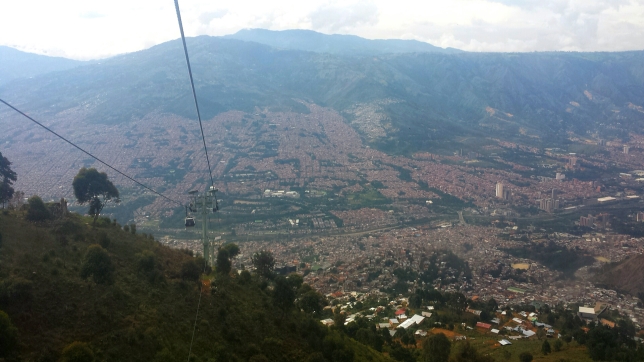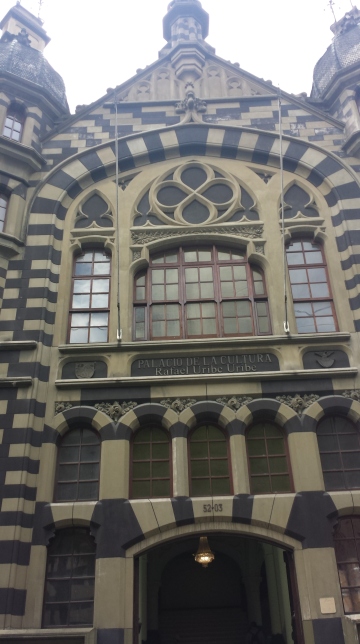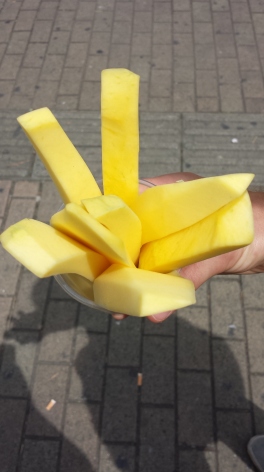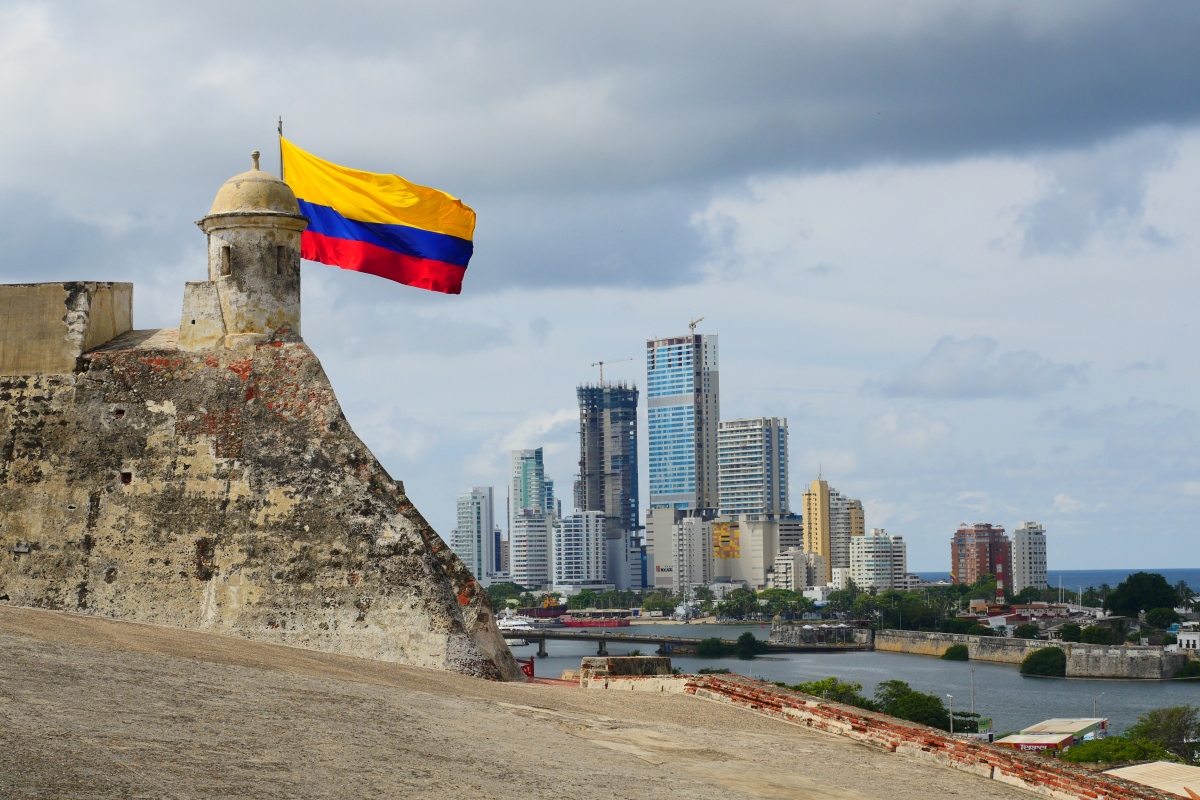Part I: An Inside Look
Dan and I had a very unique experience before we left Cartagena. Ana, co-founder of FEM (a nonprofit organization that helps the kids of Cartagena), took us on an inside tour of the real Cartagena: the slums.
It was both heartbreaking but eye opening. Not only did I learn more about the people and the history of the neighborhoods, but I also learned what tourism really does. I felt like a jerk.
You would think tourism helps in some way.. but it doesn’t. A small percentage (sorry I do not remember the exact number) of people in Cartagena have access to running water. Majority of that small percentage is the touristy area. As for electricity, during busy season, many of the locals lose power because it is more important to give such luxuries to the tourists. Then, to add insult to injury, the people see none of the money coming in with tourism. Granted it is not necessarily the tourists’ fault, but it is easy to see tourism as the source of their continued poverty.
The insider tour was amazing! Dan and I learned more about the organization (please check them out: here, here, or here!) as well as had a first-hand experience with some of the festivities occurring in Olaya (a neighborhood considered “unsafe”).
November 11th, Cartagena celebrates its Independence! Carts of beers and arepas lined the streets and crowds wandered around to watch groups of people dancing. Kids sprayed foam and parents took pictures. Everywhere in Cartagena was full of life!
However, the day before, we were in the car with Ana, driving around the streets that even local Colombians do not visit. I can’t understand why. Maybe it was the fiesta? Or maybe misunderstanding. Whatever the case, we laughed at kids who jumped in front of the car with one hand in the air holding bottles of dirty water and the other outreached for money. Ana would roll the window down and hand out a few pesos. With a big smile and a warm, “¡Chau!” the kids received a small tip as a thank you for not spraying us. Their faces were painted and their hair was colored; their eyes full of excitement and they greeted you with a beautiful smile. It was so fun!
Once back to the walled city, I couldn’t stop thinking of those kids and how privileged I am. I do not have much, but in comparison? I am rich. I felt so bad. I wanted to fix the world. But I can’t.
Dan and I did discuss the possibility of returning to volunteer with FEM. It’s a great organization and it would be nice to give back to the people who deserve it most.
The tour was unlike anything I have ever experienced. Ana opened our eyes to the real Cartagena. It was an experience hundreds of people miss when they visit this area. But like Ana said, to be a good tourist, you must open your eyes and respect the culture you are visiting.
Colombia is trying to change the world’s view. They are not dangerous people. They want tourists to come enjoy their culture. However, Ana says in order to make tourists feel more welcome and to enjoy the positives of tourism, it must start by accepting their culture.
Apparently, Colombians are harshest on themselves. They have a lot of self hatred of their history and of their heritage. They do not embrace their diversity and they are afraid of different people, including their own (e.g. Afros, Indigenous, Romani).
November 12th is the day where all of Cartagena is partying. More so than the day before. A giant parade shuts down a major road with floats and stands for people to watch who will win “Miss Colombia.” This is also the day that Dan and I decided to fly to Medellín.
Part II: Welcome to the City
We were warned that taxis would be next to impossible to find and we should leave the walled city before noon. Our flight was around 7PM.
We sat at the airport from 11:13 AM until we boarded the plane around 6:40 PM. Our flight was about an hour. Yeah, this day sucked a little.
However, Medellín is great! The weather is perfect! No humidity and it’s not cold nor hot. It is the most ideal weather I have ever experienced. Not only is the weather great, but it’s a city! A real city in a valley! It’s beautiful.

To top it off? Our hostel is the cleanest hostel… ever. Seriously. I get new sheets every day and there’s a woman who greets me in the kitchen with a plate of freshly made breakfast and some sort of mango-orange-lime smoothie. We’re only paying $9 USD a night! Living like kings.
Okay, anyway…
Dan and I decided to do the free walking tour after we continued to hear how amazing it was. At 9:10 this morning, Dan and I (as well as our roommate, Chris) walked downhill to the Metro where we paid 2,000 COP for a one-way trip to our meeting place for the tour.
Our guide was excellent! She is a Colombian, but born in the United States (she moved back to Colombia at age 4). She is considered a “Paisa,” which is someone from a region in the northwest of Colombia. She showed us a map of the different regions so we could better understand why the separation between their own countrymen. It’s similar to the states… sort of.
The tour was four hours long and very informative. We viewed important buildings and walked down busy streets while she explained their history.

It looks like Beetlejuice would live here.
We learned more about the war in Colombia and how exactly the drugs were involved in this. Tragic story after tragic story, we heard about how, for many years, Colombians would watch their cities fall apart just as they instilled hope in their hearts. My eyes were unveiled to the true stories of what it means to be a Colombian and how much pain this country endured to get to where it is today. There is still a war present, but it is no way near where it used to be.
Our guide warned us that we would get many stares as it is still a shock for Colombians to see travelers; it had been so unsafe for so long, that the sight of foreigners is surprising. She told us to not be alarmed if they stop to take pictures or shout out “gringo” as this is not a derogatory term. Just pretend you’re a celebrity for a day.
Every church we passed, street we crossed, shop we continued through, and park we sat in, we were stared at. People stopped to point us out and some really did take pictures. Some shouted out asking our nationalities and some shouted for the tour guide to speak Spanish so they could understand. It was incredible.
Before this tour, I thought all the eyes were telling us to “get out” or were for racist reasoning. However, it is quite the opposite. Seeing tourists means hope. It means the country is really on the brink of peace. It means so, so much more than I can explain. You would need to come see this country for yourself. Take a tour. Feel the pain they felt and see the places where bombs took lives. Look at the faces of policemen who are only 18 years of age. Embrace the stares and flash a smile. Return the hello.
I would go into great detail of this tour, but I will save it. Instead, I will share my favorite highlights.
- Fruit!
During the tour, we were allowed a quick break to grab a snack. Excited for some fresh fruit, I had Dan get us some mango.

I took a big bite only to discover it was not yet ripe. It was the most sour, awful thing I could imagine.
So, I decided to go back and order this mix fruit drink…thing. I forget the name, but it was a blend of strawberry, mango, banana and I believe grapes. It also included some sort of sweet sauce that was dolloped at the bottom of the cup and on top of the tasty beverage.
Excited, I walked towards the group to show Dan I had found a better treat. Lifting a big bite towards my mouth, I stepped into a hole in the sidewalk and the mix of sticky fruit sloshed down my face and down my shirt. A few people in the group gasped as I walked over, embarrassed, asking Dan to hold it while I cleaned myself.
A good quarter of this drink was now in my bra and down the front of my shirt. I appeared back at the fruit stand where I grabbed several napkins to scoop fruit out of my top. One of the employees signaled for me to use their sink. Very nice of him.
Aside from the embarrassing spill, the drink was very tasty! I enjoyed the rest of it, being very careful as I spooned each bite.
- Empanadas!
Later in the tour, we received a second break to grab another snack. During this time, Dan and I each grabbed an empanada. I have always loved these little fried pockets of joy, but having one in Colombia is much more than anything I have tried before.
Stuffed with beef and cheese and fried to absolute perfection, we scarfed them down while spritzing each bite with squirt of avocado.1
- Willy!
An older gentleman, who had butted his way into one of our groupings, pulled Dan and I aside after the group had dispersed. Willy spoke perfect English and he was so very excited to talk to some foreigners. (We were warned to not talk too long as Colombians will never shut up.) After hearing we were from the States, he asked where. We told him Colorado and he lit up! He was very excited. Willy said he had seen Colorado in movies. “With the mountains and the… the…” he took a second to find the word, “…cowboys!”
I laughed. What a cute old man.
We inched away and I told him we were going to find some empanadas (mentioned above) and he insisted we try it with the avocado (also mentioned above).
- Nosy people!
Usually, nosy people are annoying, right? Not here. It’s actually really amusing. Our guide informed us that Colombians are very curious people and when they see a crowd, they assume something is being sold or given away and so they want to join. Every time we stopped to group up and talk, Colombians would peep their heads in and look around, waiting to see what was going on. Some would stop and stare. Some would shout for her to speak Spanish. At one point, our guide told us to make sure the group circle was tight and left no gaps so that people wouldn’t distract us so much.
At one stop, we were facing a painting that had angled, reflective glass that I could glance up and watch the people walking by. It was so amusing, I had difficulty stifling my giggles. Children, old women, old men, young men, everyone! They looked puzzled. Most walked away with a confused look on their face and others walked away smiling.
- The Metro
Not only is the Metro extremely smooth and easy to use, but it provides great symbolism for Medellín. After the long history lesson and the tragic stories, our guide brought us to a conclusive and happy (open-)ending. She asked us to observe the Metro; there is no trash, no stickers on the seats, no vandalism. It is a respected symbol of unity and hope. The Metro was built when it seemed the country, and Medellín, would only fail. When all hope was lost, the Metro was born. It put them into great debt, but it powered up a light of change and growth. It took the people to come together to overcome their struggle and to realize that no matter how terrible, they are strong in unity.
I have a newfound love and respect for Colombia and I am excited to continue learning about this wonderful, resilient country.
Oh and the title of this entry? Papaya is when you give someone the opportunity to steal your things. For example, a phone in the back pocket. It’s just so sweet and succulent, it’s hard to pass up. If you give them papaya, it is your fault.
Until next time,
-B
1Avocado comes in a squirt bottle. So does pineapple. Very strange, but awesome.
